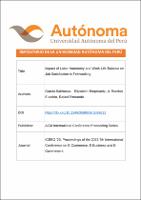| dc.contributor.author | García-Salirrosas, Elizabeth Emperatriz | |
| dc.contributor.author | Rondon-Eusebio, Rafael Fernando | |
| dc.date.accessioned | 2023-12-21T19:44:19Z | |
| dc.date.available | 2023-12-21T19:44:19Z | |
| dc.date.issued | 2023 | |
| dc.identifier.uri | https://hdl.handle.net/20.500.13067/2915 | |
| dc.description.abstract | The objective of this research was to determine the impact of work autonomy and work-life balance on job satisfaction in teleworking. The non-probabilistic sampling technique was used for convenience, cross-sectional of causal relationship through the structural equation model (SEM). The study population was made up of people residing in Lima who reported having been working in the teleworking modality. The sample consisted of 326 teleworkers (65.3% women and 34.7% men). The results showed that both work autonomy and work-life balance have a direct, positive, and significant impact on job satisfaction; being the work-life balance the one that presented a greater impact on job satisfaction (R=0.679, p<0.000). Likewise, labor autonomy presented a minor impact (R= 0.405, p<0.000), but equally important.
The global health crisis caused by the COVID-19 pandemic conditioned organizations to adopt the teleworking modality on a mandatory basis in several of their operations , registering an increase in the emotional exhaustion and work burnout that impacted the quality of life , mental health and job satisfaction of workers due to the effort in adapting to the job and the context they faced [1], [2] Among the most noticeable health consequences resulting from this situation were increased anxiety and sleep disorders [3], which had consequences on the effectiveness of the assigned functions and the productivity of workers [4], [5]. In addition, the abrupt change to teleworking affected the daily work obligations of the worker since they had to face the difficulties of the family environment and other events that impacted the development of their work responsibilities [6]. Due to this situation , managers developed new strategies with the help of technology to ensure employee productivity under the condition of teleworking [2], [7]. As a result, the flexibility of working from home became a new way of operating for many workers and a new work culture for organizations that, in some cases, extended beyond the mandatory restrictions and continued after the restart economy and the decrease in the post-pandemic health crisis [8]. | es_PE |
| dc.format | application/pdf | es_PE |
| dc.language.iso | eng | es_PE |
| dc.publisher | ACM International Conference Proceeding Series | es_PE |
| dc.rights | info:eu-repo/semantics/restrictedAccess | es_PE |
| dc.rights.uri | https://creativecommons.org/licenses/by/4.0/ | es_PE |
| dc.subject | Teleworking | es_PE |
| dc.title | Impact of Labor Autonomy and Work-Life Balance on Job Satisfaction in Teleworking | es_PE |
| dc.type | info:eu-repo/semantics/article | es_PE |
| dc.identifier.journal | ICEEG '23: Proceedings of the 2023 7th International Conference on E-Commerce, E-Business and E-Government | es_PE |
| dc.identifier.doi | https://doi.org/10.1145/3599609.3599621 | |
| dc.subject.ocde | https://purl.org/pe-repo/ocde/ford#5.02.04 | es_PE |
| dc.relation.url | https://dl.acm.org/doi/10.1145/3599609.3599621 | es_PE |
| dc.source.beginpage | 79 | es_PE |
| dc.source.endpage | 86 | es_PE |


